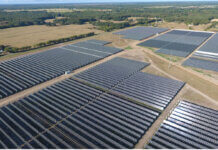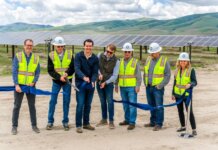As the solar revolution picks up even more speed, a growing number of utilities and municipalities are jumping on the bandwagon, but they need the right partners to succeed.
For the past five years, the solar revolution has continued almost unabated as more consumers found solar energy to be an excellent investment, both to improve their homes’ value and reduce their electricity bills.
Often, however, the largest obstacle to commercial and community solar installations, at least until recently, has been the utilities. Frequently state regulated, with guaranteed profits and with an enormous fossil-fuel infrastructure, utilities have seen solar as direct competition. After all, having customers produce their own power flies in the face of traditional, centralized electricity distribution.
But, surveying the landscape of the solar industry today, we’ve seen that slowly evolving.
Many U.S. cities and towns have joined the Sierra Club’s Ready for 100 campaign, which has worked hard to help get local governments to commit to 100% renewable energy. And public utilities commissions in states like California have been require utilities to account for renewable energy and battery storage in their long-term planning.
The solar revolution is here – and the smart utilities are getting on board.
Although some of the biggest utilities outside of California are still struggling to deal with integrating solar into their portfolios, there are many utilities that get it. Some are large – Duke Energy and Dominion Energy, to name but two. Some are small, such as the Jacksonville Electric Authority (JEA) in Florida and River Falls, Wis., Municipal Utilities.
As this article will explore, forward-thinking utilities are already on board and are capitalizing on the rapidly expanding market. And municipalities are finally recognizing that even in “non-sunny” states, solar gives them the opportunity to break utility monopolies and save their cities money, not an insignificant consideration in an era of tight budgets and ever-shrinking tax bases.
Eventually, we at Standard Solar believe all utilities will have to embrace solar, and the sooner they do, the better. Fortunately, the aforementioned utilities could provide blueprints for others to follow.
The Current State Of Play
Since the solar industry has become a more significant part of the U.S. electricity mix, utilities and solar have had an uneasy relationship. After all, these two varied segments of the electricity-generation universe are both dichotomous and symbiotic.
On the one hand, distributed-generation solar is a direct threat to the traditional utility business model, which consists of centralized electricity production pushed over transmission lines to customers. Losing customers to self-generated solar lowers revenues and investor dividends.
On the other hand, solar currently needs the distribution and transmission lines utilities have built to get the power from the panels to the people and to transmit any excess electricity they produce.
Like we said – competitors who need each other. It’s hard to think of another industry in which such a relationship exists.
Still, in recent years, more utilities are warming to the idea of solar electricity as a potential new income source and have started building their own utility-scale solar plants as their customers demand a move away from fossil fuels to solar energy.
The Solar Energy Industries Association (SEIA) reports that as of 2016 (the most recent year for which full-year statistics are available), there were more than 6,000 utility-scale projects 1 MW or larger operating in the U.S. Back-of-the-envelope math reveals that’s 6 GW of utility-scale solar – nearly one-sixth of the entire installed solar capacity in the U.S. (at the end of 2016, the number stood at 40 GW).
Of that, 2.9 GW were comprised of photovoltaic (PV) utility plants, and SEIA says more than 26 GW of PV plants are currently in the works.
The bottom line: Despite concerns that increased solar would destabilize the grid or eat into their profits significantly, many utilities have seen the future, and it is solar.
Here’s how four non-California utilities are embracing solar long before they are forced to do so.
Duke Energy
Thanks to the Public Utilities Regulatory Policies Act of 1978 (PURPA), which legally requires utilities to buy power from independent power producers (IPP) if it is below their cost of generation from other sources, also known as “avoided costs,” Duke Energy was one of the first non-California/Arizona utilities to recognize – and capitalize on – the rapidly expanding solar market.
The utility says it has plans to contract with developers to build around 600 MW of new solar capacity this year as part of the newly created competitive bidding procurement program in North Carolina alone. Thanks to new support from the state government, Duke has pledged to add nearly 3 GW of solar capacity to North Carolina over the next few years.
River Falls Municipal Utilities
River Falls is a city of 15,000 in western Wisconsin, so close to the border of Minnesota that it actually lies within the metropolitan statistical area of Minneapolis-St. Paul. It receives its electrical service from the River Falls Municipal Utilities (RFMU).
Unlike Duke, which has massive areas of undeveloped land within its service area, RFMU does not. To maximize its solar-produced electricity, it created a robust community solar program, into which consumers can buy at $567 per share (and it provides a calculator for residents to figure out how many shares they will need to power their homes).
As with most utilities, RFMU decided to add solar to its offerings not just because it was the right thing to do for the environment, but also because their customers demanded it – and it expects the demand to continue growing.
Dominion Energy
One of the more forward-thinking of the investor-owned utilities, Dominion Energy realized early on that it should not waste one of the most valuable resources of its native Virginia (the utility is headquartered in Richmond). Thanks to the availability of suitable sunshine, favorable state electricity policy and a desire to be more environmentally friendly, Dominion Energy tops most solar-friendly utilities lists.
In Virginia, the last governor signed multiple bills into law to encourage solar development in the state, and Dominion has been on it, issuing a request for proposals (RFP) for new solar development.
Since 2013, Dominion helped bring 1.2 GW of large-scale solar into operation and says it has invested $3.6 billion in solar procurement—and shows no signs of slowing down.
Jacksonville Electric Authority
Commonly known in the industry as “JEA”, the Jacksonville municipal utility had to wait a long time for state policy to allow it to invest in solar significantly, but, like its bigger competitor Florida Power & Light, it has pushed forward at lightning speed since the laws were changed in 2016.
In October, JEA announced plans to add 250 MW of new utility-scale solar capacity by 2020, expected to be built and owned by independent power producers. When completed, the projects will be added to the 50 MW the utility already owns – and at 300 MW serving 450,000 customers, it will have one of the highest solar penetration rates of any utility in the country. For a utility so small, that’s an incredible achievement and should serve as a blueprint for other municipal utilities to follow.
What We Have Learned From Our Work With Utilities
As more utilities begin adding solar to their portfolios, more solar companies will have the opportunity to work with them. So, it’s a fair question to ask: What are utilities looking for in a solar partner?
Over more than 12 years of working with utilities, we’ve learned a bunch of lessons about what they are looking for in a partner. Although each utility is different and has its own list of criteria, here are a few that have run across though all of our interactions:
Demonstrated expertise. When the Choptank Electric Cooperative in Maryland was looking for advice about a solar array it wanted to install, the company was specifically seeking expertise in LEED certification, something we had helped other clients do. Understanding what expertise utilities are looking for will save them time looking through résumés and will demonstrate to them you aren’t going to waste their time. When they are juggling so many projects at once, that’s invaluable.
Financing contacts. Utilities (smaller ones like JEA, in particular) often don’t have the money in-house to finance solar projects. That was the situation when the Kit Carson Electric Cooperative in New Mexico came to us to build a solar array for it. The contacts and network we’d established among lenders allowed us to find the financing deal that was right for them.
But those contacts don’t come from sitting behind a desk in your office. It’s your obligation to yourself and your clients to go to industry trade shows and smaller, more-localized events and meet with as many financing people as possible. If you build that network, utilities will flock to your doors.
An ability to work well with others. As always, it pays to know what you don’t know. It would have been difficult for us to learn the entire legal framework for New Mexico’s renewable portfolio standard before starting work with the Mora-San Miguel Electric Cooperative. So, we partnered with a local company in a way that benefited us both. Don’t be afraid to say you don’t know – you might be surprised at how much the utility appreciates your honesty.
What Does The Future Hold?
As the aforementioned examples show, the solar revolution won’t be ending anytime soon for utilities and municipalities. Prices for solar installations continue to plummet (for now), and demand for clean energy continues to grow. The longer these trends continue, utilities will see the wisdom of embracing – instead of fighting – solar’s continued proliferation.
Some states are even beginning to mandate that utilities look for alternative sources of electricity production. In California, for example, new and existing natural gas plants are receiving a jaundiced eye from the Public Utilities Commission, and new plants are being denied with the additional directive of finding renewable (read: solar) alternatives. The states are starting to get on board, and it would behoove utilities to get ahead of the trend.
Utilities are realizing that the old business model of using fossil fuels is neither economical nor prudent public relations. In 2017, utilities retired myriad coal plants. And although not all of those were replaced by solar farms, the continued closures, which utilities have not backed off despite the current Trump administration’s support for fossil-fuel interests, provide an enormous opportunity for the solar industry – and utilities wise enough to recognize it.
Scott Wiater is president and CEO of Maryland-based Standard Solar.
Photo: Standard Solar built a 1.5 MW solar array for Kit Carson Electric Cooperative.




